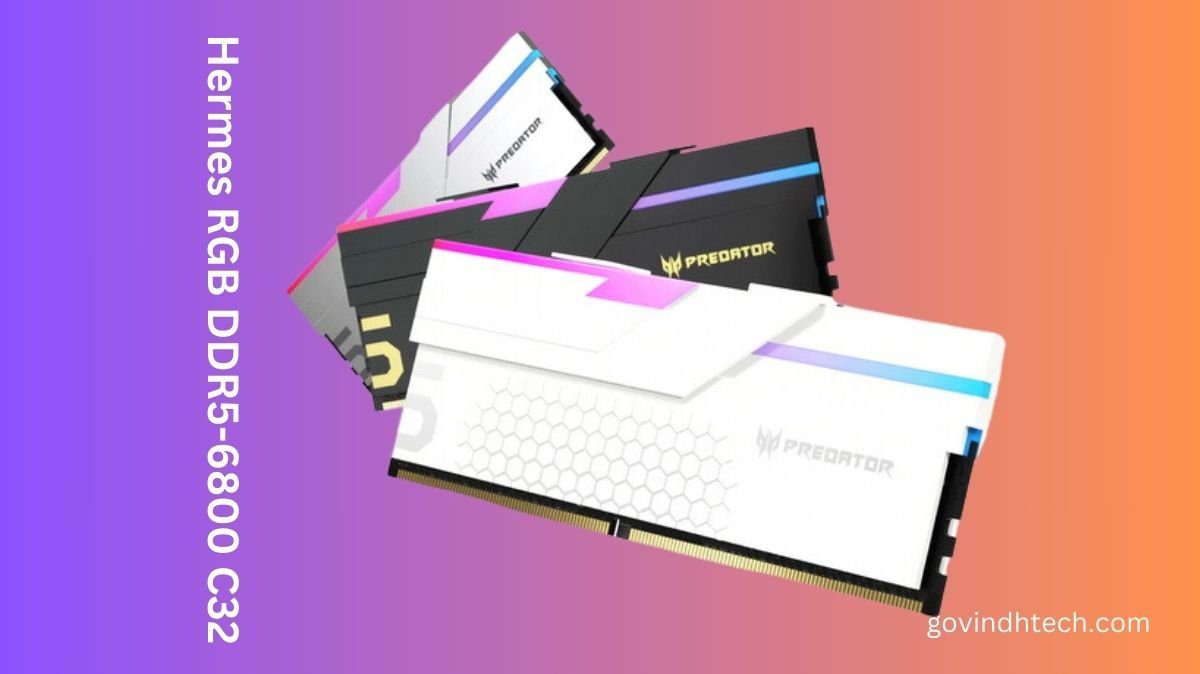According to Zhiye Liu RAM Reviewer and News Editor of toms hardware, the Hermes RGB DDR5-6800 C32, the newest DDR5 memory from Predator Storage, appears to be competitive and ready to take on the best RAM available. In the memory market, Predator Storage Acer‘s premium gaming brand, whose goods are manufactured by Biwin is by no means a well-known name. Still, the business has made an effort to become well-known. Predator Storage has upgraded to DDR5, just like a lot of memory suppliers. The Hermes, Vesta, and Pallas II series make up its current DDR5 lineup. The Hermes series is the top of the line, with glaring frequencies up to DDR5-8000 and capacities up to 64GB (2x32GB).
Performance Metrics: Hermes RGB DDR5-6800 C32 2x16GB Explained
The aluminum heat spreader on the Hermes memory modules is available in white, silver, or black. Its thickness of 1.9 mm aids in the dissipation of heat. With its unique combination of diagonal highlights, a honeycomb pattern, and intense RGB lighting, the heat spreader’s design really pops. The fact that the heat spreader only has the Predator logo and minimal marketing is a great move by the brand. The memory module is identified as DDR5 by a tiny “5” in the corner.
An additional 40 x 40mm cooling fan is available for Predator Storage, along with a bracket and screws to attach it to your motherboard and add additional cooling for the modules. A brushless fan with a maximum airflow of 4.72 CFM and a noise level of 29.9 dB is the Boosfan JD4010M. Sadly, overclocking-focused motherboards with dual memory slots cannot use the cooling fan because it was intended for motherboards with four memory slots.
Given that the Hermes memory modules are 51.20mm (2.02 inches) tall, especially if you’re using a large air cooler, you should consider the clearance space for your CPU cooler. Users of liquid cooling don’t need to worry as usual. The Hermes is brightly illuminated in eight separate lighting areas thanks to the RGB light bar. Fortunately, you can tweak the lighting using the software on your motherboard. Asus Aura Sync, Gigabyte RGB Fusion 2.0, MSI Mystic Light Sync, and ASRock Polychrome Sync are all compatible with the Hermes memory modules.
The memory modules use a black-dipped 10-layer printed circuit board. You will get two 16GB DDR5 memory modules with a single-rank design since it is a 32GB memory kit. The SK Hynix integrated circuits (ICs) are the H5CG48AGBDX018 (A-die) models, which are excellent for overclocking. The memory modules, which contain eight A-die ICs, use the 2GB version. The power management IC (PMIC) had faint markings, but it does display the Global Mixed-mode Technology (GMT) 5100 module.
The Hermes memory modules default to DDR5-5600 with 46-45-45-90 timings if the user doesn’t intervene. The memory kit has support for XMP 3.0 because it is designed for Intel chips. The DRAM voltage and required timings will be set to 1.4V and 32-45-45-108, respectively, by the DDR5-6800 profile. With the 7D28vAA firmware, the Core i9-13900K is operating on the MSI MEG Z690 Unify-X in the Intel test system. AMD system, on the other hand, pairs the Ryzen 7 7700X with the MSI MPG X670E Carbon WiFi, which has been updated to the 7D70v18 firmware. The operating temperatures of Raptor Lake and Zen 4 processors are regulated by the Corsair CUE H100i Elite LCD liquid cooler.
It makes sure that gaming RAM benchmarks don’t have a graphics bottleneck by assigning the MSI GeForce RTX 4080 16GB Gaming X Trio to handle the more demanding workloads. Crucial’ s MX500 SSDs house the Windows 11 installation, benchmarking software, and games. In the meantime, systems are powered cleanly and abundantly by the Corsair RM1000x Shift ATX 3.0 power supply, which powers the GeForce RTX 4080 directly through a native 16-pin (12VHPWR) power cable. Last but not least, keeping hardware organized depends on the Streacom BC1 outdoor test bench.
Hermes’s performance was up to par. It was unable to compete with memory kits priced at DDR5-7000 and higher. Due to the tighter memory timings, it was the fastest of the two DDR5-6800 memory kits.
Surprisingly, the Hermes outperformed the AMD platform’s Trident Z5 RGB DDR5-7200 C34. Predator Storage’s memory timings were lower, which helped in this instance but not on the Intel platform, even though the latter is binned at a higher data rate.
Even with SK Hynix A-die ICs, the Hermes memory kit didn’t show off astounding overclocking potential. It did, however, peak at DDR5-7200, surpassing the DDR5-7000 attained by the Trident Z5 RGB DDR5-7200 C34. The memory timings were not compromised in any way. We managed to stabilize the memory at 32-42-42-92 and 1.45V, which is marginally superior to the XMP timings.
Using the Hermes, we were able to get the ideal timings for a DDR5-6800 memory kit. We were able to change the timings from 32-45-45-108 to 30-40-40-90 by raising the DRAM voltage from 1.4V to 1.45V. Since that A-die integrated circuits aren’t known for their precise timings, it might have just been a case of lucky silicon.
Regarding performance or looks, you shouldn’t have any issues with the Hermes RGB DDR5-6800 C32. Excellent performance is available right out of the box with this memory. The Hermes RGB DDR5 currently has the lowest memory timings available for a Predator Hermes RGB DDR5-6800 memory kit, which is helpful. While it’s a nice idea, adding a 40mm cooling fan isn’t really necessary. It can only be used with four DIMM motherboards due to design limitations, and the additional cooling that the fan offers is not necessary unless you’re severely overclocking the memory or your case has limited airflow.

